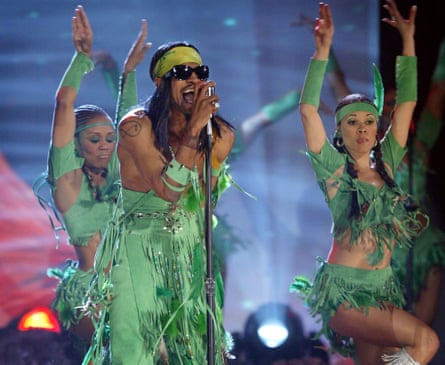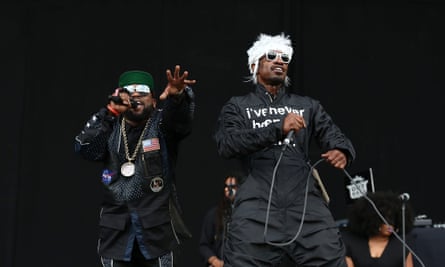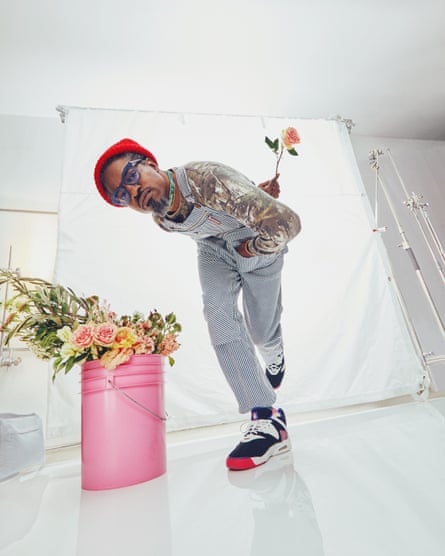For the past four years, André 3000 sightings have practically become a thing of folklore. The circumstances tend to fit a pattern: someone stealthily films the Outkast legend playing a wooden double flute in public, which triggers a social media frenzy. It’s like glimpsing Pan, the Greek god of the wild, jamming in solitary reverie at an outdoor yoga class in Philadelphia. He has also popped up in coffee shops, the streets of Tokyo and airports worldwide.
You are most likely to spot André in Venice, California, where this reclusive rap great resides when he is on the west coast. Here, on a Friday afternoon in late October, this mystic apparition is tooting his cedarwood Mayan instrument among the organic cafes and haute couture boutiques. Two professional camera operators are shooting the scene for a documentary about the creation of his long-awaited debut solo album, New Blue Sun, an instrumental epic of celestial new age and meditative ambient music. The lunchtime crowd at the Michelin-recommended restaurant where he sits down is delighted.
“It’s almost like a Where’s Waldo thing,” says André in a sumptuous drawl. He slides into a seat at a small table for our interview, resting his hefty, hand-carved Mesoamerican woodwind on a ledge. “‘We saw André playing his flute in the airport! We saw André playing the flute on Abbott Kinney [Boulevard]!’ I felt like: damn, they’re always just catching me noodling around.” Sure, he has a film crew with him today, but usually “I’m just trying to go to Starbucks! I like to walk, I like to hike and I love playing. So I just never stop.”
The Atlanta native, born André Benjamin, is aware that it looks a little weird. He would be in on the joke, except that it isn’t one. His half‑decade quest to master the flute has led to the eight tracks that comprise New Blue Sun, culled from dozens of sessions recorded at Rick Rubin’s Shangri-La studio. André, on digital woodwind (“this weird wind-synth thing”), is accompanied by some of Los Angeles’ best jazz and avant garde musicians: Carlos Niño, Nate Mercereau, Surya Botofasina, Matthewdavid, VCR and more.
André’s jazz odyssey began with John Coltrane. At first, he took up the saxophone, but soon switched to Coltrane’s first instrument, the bass clarinet, which led to the flute. “There was something softer and smoother about the tone of woodwinds,” he says. “It just felt right to me.”
It is one of the most radical evolutions in pop history. New Blue Sun features no raps. The first track is titled I Swear, I Really Wanted to Make a “Rap” Album But This Is Literally the Way the Wind Blew Me This Time. “I get it. I already expect what’s going to happen. I’m just so happy to share it,” André says, with disarming sincerity. “I really wanted to make a rap album, because in a way you really do want to please your fans. I’d love to shut motherfuckers up.” Instead, New Blue Sun captures the reawakening of a beatific spirit, living up to the mantra of not worrying about what anyone else thinks, laid out by André 25 years ago on the Outkast track Liberation: “Now that’s liberation and, baby, I want it.”
“As a kid, I drew and painted and thought that I’d go to art school,” he says. André is wearing pinstripe painter’s overalls that hang loosely over a camouflage shirt. A navy-blue beanie covers a greying tuft of hair. Retaining the sartorial flair of the man who co-wrote So Fresh, So Clean, he is immaculately accessorised in round caramel glasses, turquoise shell necklaces and a thick gold bracelet; think Dizzy Gillespie if he were into surfing and abstract expressionism. “Even when I first started rapping, I didn’t necessarily think I’d end up producing or doing [2003’s adventurous album] The Love Below,” he continues, with none of the affectation you might expect from an artist who has won seven Grammys (six with Outkast) and sold 20m records. “I’m always interested to see where I am going. I’m watching it happen, too. It’s not like I won’t rap ever again, but this naturally blew this way and felt worthy to share. It’s the most honest thing I can be doing.”
You cannot ignore the messianic expectations that accompany an André solo record. Since the last Outkast album, in 2006, rumours have circulated occasionally about studio sessions with big-name producers. Instead, he acted in about a dozen movies and television shows including a Jimi Hendrix biopic and last year’s acclaimed dramedy Showing Up. He was the face of Gillette, created and voiced an Adult Swim cartoon (Class of 3000) and started a short-lived clothing line inspired by the aesthetics of 1930s Ivy League football (Benjamin Bixby).
There was some music. André and Beyoncé covered Amy Winehouse’s Back to Black on the soundtrack to the 2013 Great Gatsby adaptation. There was a 2014 Outkast reunion, whereby André and Big Boi performed their greatest hits at more than 40 festivals. In 2018, two songs dropped quietly on SoundCloud, featuring André on bass clarinet alongside James Blake playing piano. Every so often, he delivered a dazzling guest verse on a blockbuster album: Drake, Frank Ocean, Kanye West.
“It was a fun challenge to jump on other people’s songs,” says André. “It’s always easier to attend someone else’s party than to throw your own. When a sound and generation is changing, there’s nothing you can do except figure out how you fit into it. Those artists kept me alive, in a way – especially for younger people who don’t know about Outkast.”

As for solo music, accolades and fame became restrictive. André’s stage name nods to the future; releasing anything short of axis-shifting would be considered a disappointment. Outkast’s first four albums not only helped invent and define southern hip-hop, but they also expanded the possibilities of music itself. Outkast are their own genre – bringing together virtuosic rap storytelling, soul, Afrofuturism, blues, rave, gospel and funk. Just as creative differences pulled them apart – André tilted towards eclectic guitar pop inspired by Prince and the Beatles, while Big Boi leaned towards a harder-edged fusion of hip-hop and classic soul-funk – Outkast became the biggest crossover rap group in history. Few albums have achieved the ubiquity of Speakerboxxx/The Love Below, which produced Hey Ya!, which André performed in electric-lime buckskin at the 2004 Grammys. Outkast took home three awards that night – and never returned.
What do you do when you have done all that by the age of 30? “As you get older, honesty and beauty became way more important than anything else,” André says. “You realise that you won’t be here at some point, so the choices you make are like: when I’m gone, what am I leaving behind? New Blue Sun is a piece of beauty. It’s more valuable to me than saying another rap about how dope I am or how I think this girl is fine. And those are human things, but there’s a certain value system that I’m trying to deal with.”
If this project gelled with relative ease, little else has been simple. Since Outkast disbanded, André has faced writer’s block and self‑doubt, depression, social anxiety and hypersensitivity disorders. His parents died suddenly within a year of each other, his mother in May 2013 and his father in February 2014. For a long time, the path forward remained murky. “You need to keep doing things that keep you inspired. I’m just trying to find a way to keep going,” he says. “Sometimes, if you hit a wall at one thing, changing it up lets you reach that next step – like Picasso switching between sculpting and painting. I’m always trying to do what allows me to find wonder.”
The waiter asks André if he wants any food, but he doesn’t order so much as a cup of water, saying that he has already eaten. His eccentricities were parodied on the sketch comedy show Key & Peele, in which André skipped into a coffee shop, dressed like a Swiss yodeller, and ordered a “half-caff decaf mint mocha latte with foam on the bottom, served in a flower vase”. Here, his temperance seems almost monkish.
The journey to New Blue Sun was sparked by a chance encounter with Niño, a venerable figure in LA’s experimental music scene, at a Venice supermarket. The composer, producer and percussionist invited André to a performance that night, at which Niño and friends played the music of Alice Coltrane. André had been listening to her all week and interpreted this as a sign. He arrived at soundcheck and stayed until the band left, taking photos with anyone who asked.
“He’s incredibly humble,” says Niño, who served as the chief collaborator and unofficial executive producer of New Blue Sun. “He considers himself new to all of this, even if he inspired a lot of these musicians at the sessions. Even if this isn’t hip-hop per se, it’s a continuation of his approach: the same breath control, ingenuity, experimentation and creativity.”
Then came the pandemic. When lockdown lifted, André trekked to Niño’s garage studio in Canoga Park for two four-hour sessions in trio and quartet formation. Six months later, André called Niño to tell him that he had been listening nonstop to their recordings and wanted to pursue that direction. From there, they recorded endless hours of music together. At Niño’s invitation, the elite talents of the LA experimental scene came on board.

Although the wooden double flute is his current companion, on New Blue Sun, André opted for a digital wind instrument with which he was unfamiliar. “What you’re hearing is me playing 20 minutes after opening it up out of the box,” he says, laughing. “I’m trying to figure out what I can do. It’s pure discovery and excitement – like watching a child see bubbles for the first time.”
He is being modest. While André isn’t a Juilliard-trained flautist, he possesses an intangible musicianship that no teacher could impart. (Recall the John Coltrane aphorism: “You can play a shoestring if you’re sincere.”) And this is no vanity project. New Blue Sun betrays the influences of John and Alice Coltrane, Steve Reich and Philip Glass, Laraaji and Yusef Lateef. There are gongs, three-stringed Moroccan lutes and André performing something he calls “panther toning” on a song called That Night in Hawaii When I Turned Into a Panther and Started Making These Low Register Purring Tones That I Couldn’t Control … Sh¥t Was Wild. It reflects his attempt to mimic an ayahuasca ritual in which he felt himself being transformed into a panther and started making involuntary noises. “If I would have had a tape recorder that day, I would have hit record, because it was awesome to hear,” he says, theorising that the psychedelic drug “was playing me as if I was this vibrating instrument”.
He knows that it sounds bizarre, but he has developed a certain Zen about it all. “I had to develop an understanding that there may be opposition to this,” André says. “But the feeling I got making it – the love I had for the music – was much greater than the fear.”
Of course, the Outkast questions never go away. The duo never formally split and, as they took different paths, their timeless catalogue influenced rap’s next generation, including Tyler, the Creator, Kendrick Lamar and J Cole. Despite their lack of collaboration – or perhaps because of it – André and Big Boi remain close. André describes their relationship as “awesome” and mentions Big Boi’s excitement at his latest left turn. “Like all relationships, it’s a chemistry thing. Sometimes, you need a new formula that keeps things fresh. He’s been one of my closest friends since before we made our first raps. I can’t rule out anything or say what will happen in the future. I don’t know where the ride is taking me.”
These days, most of André’s mornings begin with a five‑mile walk. Afterwards, he heads to his creative studio in nearby El Segundo, where he paints, sculpts, takes video calls and sketches designs for his new company, A Myriad of Pyramids, which aims to connect all of his artistic endeavours. He plays the flute throughout the day and has begun an apprenticeship to learn how to make the instrument. At night, he has vivid recurring dreams, most notably a vision that he has been having since the beginning of his career, in which he floats through the air.
“I’m always amazed that I’m flying. And I’m so amazed that I want to tell my friends,” André says. “I’m not flying with wings, but I’m hovering and I can float to certain places. But when I try to show my friends, it doesn’t work. I don’t know why that is.”
You don’t have to be a psychologist to recognise the aspirations of an artist caught between worlds: anxious to share their epiphanies, but worried that they won’t be understood. After all the years when gravity exerted its dreary force, you can finally glimpse André levitating again – so long as you are willing to listen closely, or lucky enough to catch him in the street.

